Mopping may not be the most exciting at-home activity, but it’s essential for keeping your living space sanitary. While it’s important to clean every floor in your house or apartment, the kitchen deserves extra attention. Only a good cleaning can keep your kitchen floor free from harmful bacteria and bugs. But that begs the question: how often should you mop your kitchen floor? If you’re not sure about the optimal cleaning strategy for your kitchen floors, then you’ve got to read the info we’ve compiled below.
Most cleaning experts recommend mopping your kitchen floor once per week. To make your mopping day easier, it’s a good idea to sweep or vacuum your kitchen floor once every night. However, if you ever notice a significant amount of grime or dirt, you should break out your mop immediately.
Need more tips on becoming a sweeping superstar? If so, you’re going to love skimming through all the kitchen floor cleaning tips in this post!
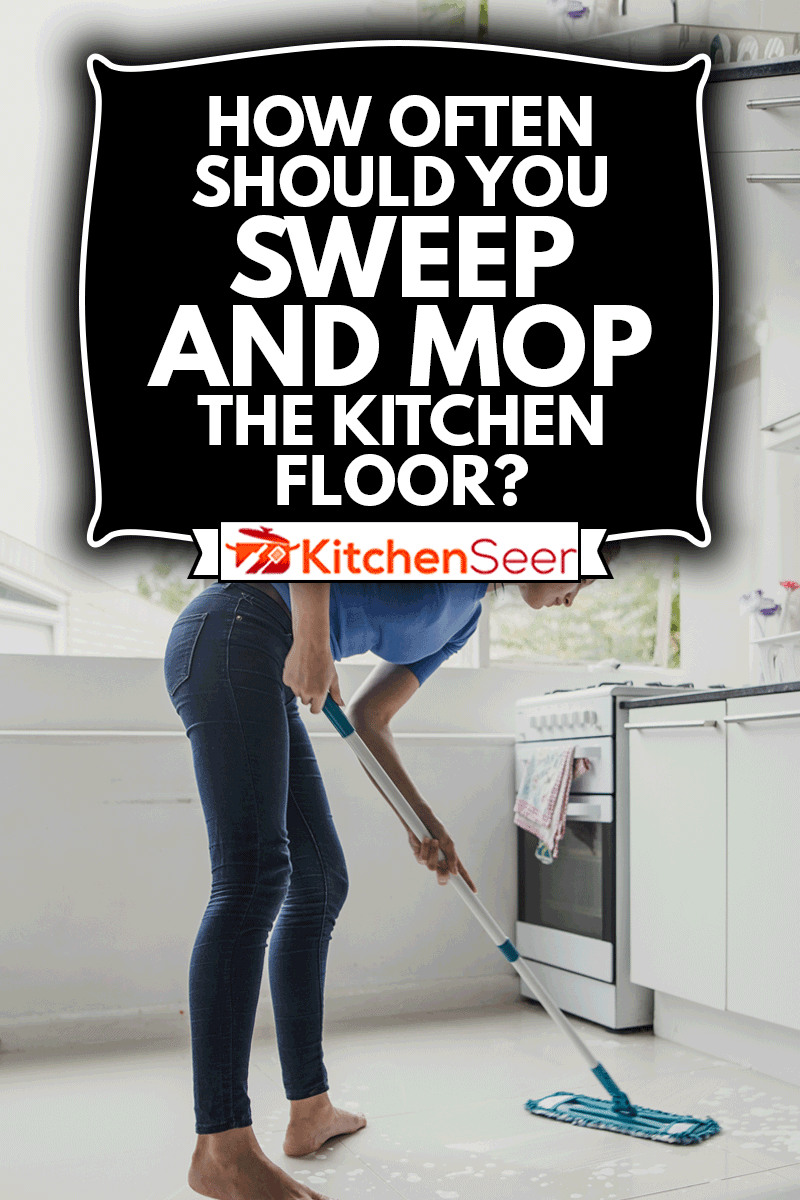
How Often Should You Mop Your Kitchen Floor?
Like bathrooms and central hallways, the kitchen is considered a “high-traffic area.” This means kitchen floors are more prone to dirt buildup than most other rooms. Plus, since the kitchen is where we cook, it’s far more likely for food or oil to end up on this floor.
For these reasons, kitchen floors require extra maintenance. In fact, most cleaning experts recommend mopping your kitchen floor at least once per week. You should also sweep your kitchen floors as often as possible to make your mopping sessions easier.
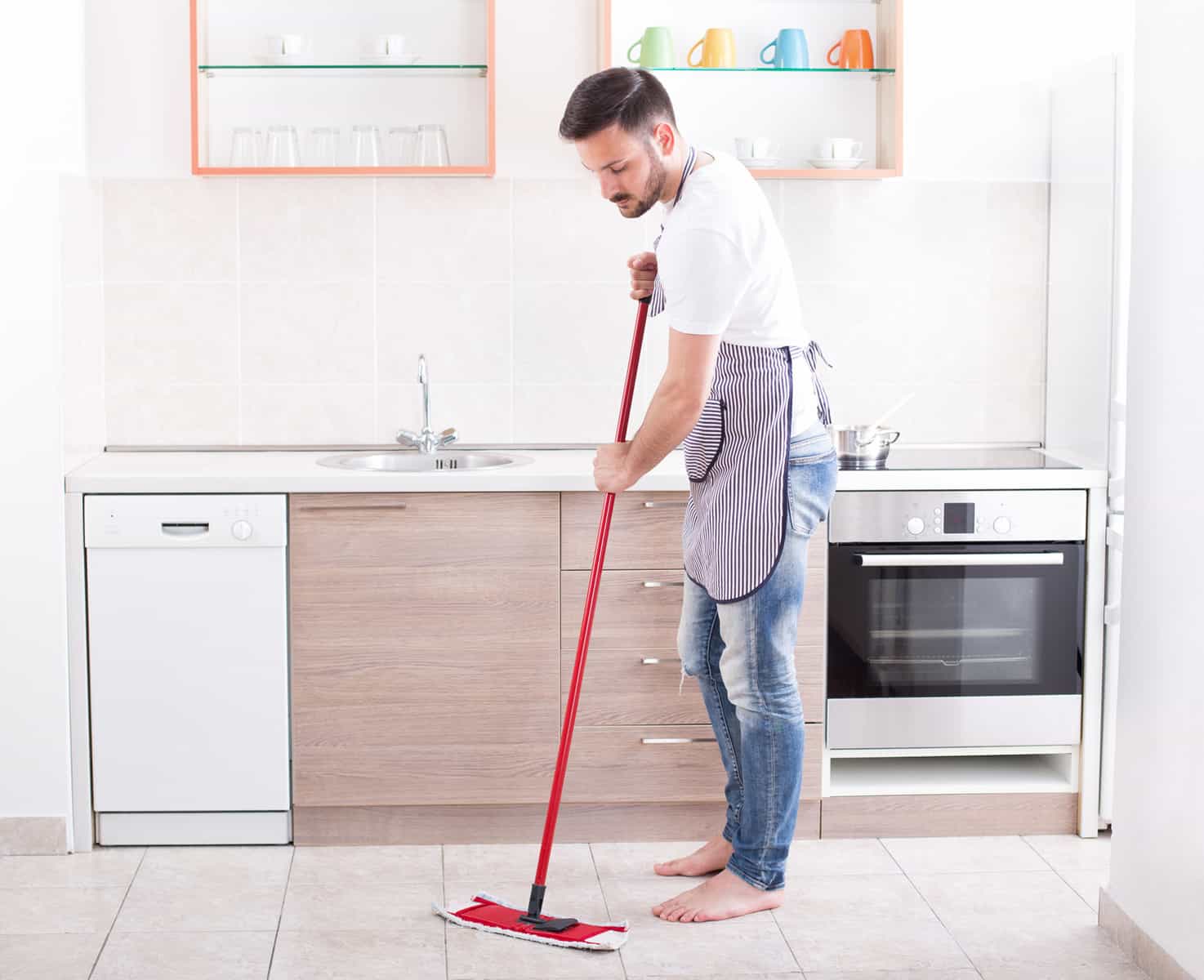
Is It Necessary To Mop Kitchen Floors Every Day?
Unless you’re incredibly messy, you shouldn’t have to mop your kitchen floor every day. In most cases, homeowners do just fine mopping their kitchen floor once per week.
However, some home experts strongly recommend “dry mopping” a few times throughout the week. Also called “dust mops,” dry mops are typically made with microfiber, which does a great job clinging to dust, pet dander, and grime. There are now a few products that work as both a dry and wet mop for extra convenience.
Find out more on this Amazon link.
Should You Sweep Your Kitchen Floor Every Day?
Even if your family isn’t super messy in the kitchen, your floor could benefit from daily sweeping. This is especially the case if you’ve got kids or pets in the house. Remember that the kitchen floor is highly susceptible to crumbs, which also means a high chance of a pest infestation. If you want to cut the risk of critters getting into your kitchen, it pays to sweep your floor every night.
Find out more on this Amazon link.
By the way, if you need extra tips on keeping kitchen pests from your pantry, you may want to read our post on “How To Get Rid Of Pantry Bugs Naturally.”
What Is The Best Way To Clean A Kitchen Floor?
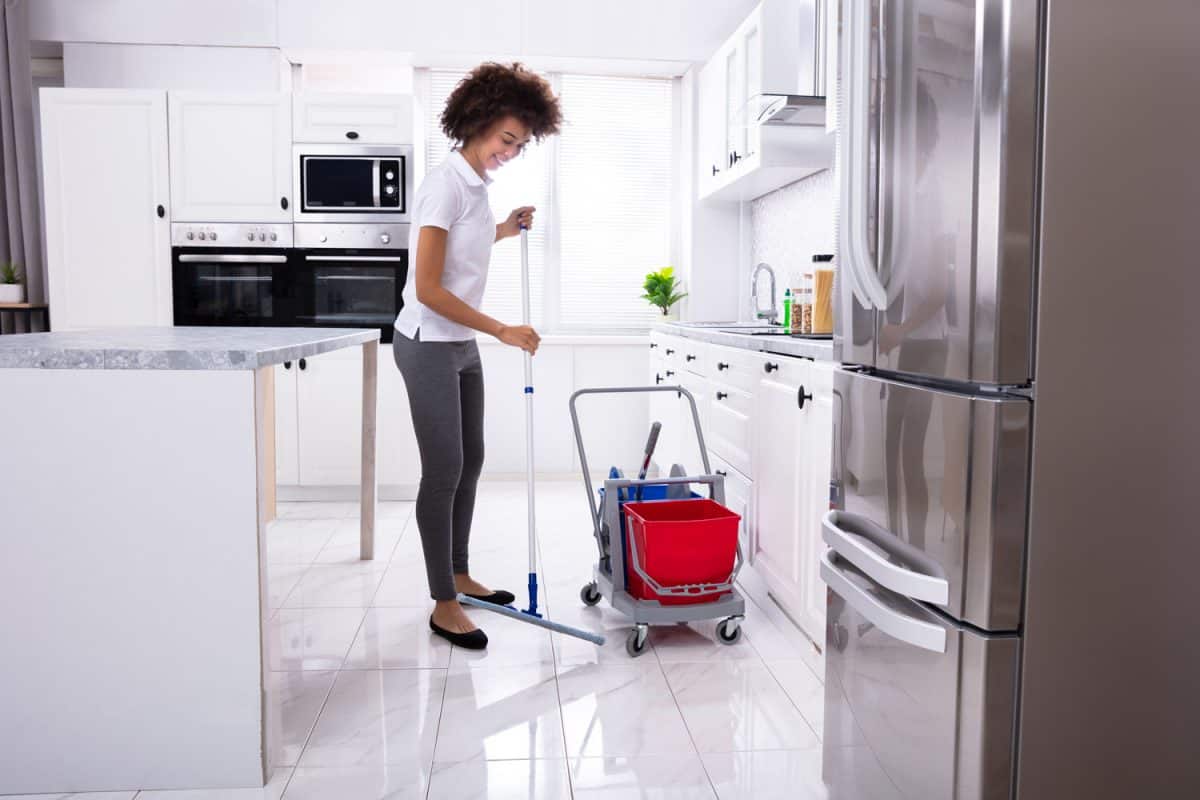
There are dozens of different techniques people use to give their kitchen floor a deep clean, but here’s a basic mopping strategy:
- Start by sweeping or vacuuming dirt off your kitchen floor.
- Fill your mop bucket with about one gallon of warm water and the recommended dose of your cleaner.
- Bring your mop and bucket to the farthest corner from where you want to exit the room.
- Dip your mop in the water and wring it out thoroughly.
- Once your mop is just slightly damp, start scrubbing your floor in long strides back and forth or figure-eight patterns.
- Continue this pattern as you work towards your exit.
- Don’t let anyone walk on your kitchen floor until it’s completely dry.
Please always pay attention to how dirty your water and mop head are as you’re cleaning your floor. You may need to stop halfway through mopping to wash your mop and add pure water with more cleaning solution. Alternatively, you could use two buckets while cleaning: one with water for rinsing and the other with sudsy “cleaning water.”
If you can’t be bothered to use a traditional bucket with your mop, you could consider filling a spray bottle with cleaning water and spraying your floor as you mop. Some people even use a cup filled with water and soap to pour as they scrub.
It’s crucial that your mopping style feels comfortable and works for your floor type. If you have any questions about what cleaner to use on your floor, you must speak with the manufacturer beforehand.
If you’d like more tips on how to mop kitchen floors, be sure to watch this popular YouTube video:
What Should I Use To Mop My Kitchen Floor?
Although traditional string mops are still around, many cleaning fanatics are going crazy for microfiber mops. This material is perfect for scooping up dirt and germs without scratching your floor. As a bonus, many of the most popular microfiber mops have removable heads that are machine-washer friendly.
Find out more on this Amazon link.
While microfiber mops are preferred nowadays, some customers are still singing the praises of sponge mops. Compared with traditional string mops, sponges retain less water, which means you won’t have to worry about excessive wringing. Plus, sponge mops tend to perform well on both hardwood and laminate floors.
Find out more on this Amazon link.
If you’re going to use a traditional mop to clean your kitchen floors, you can’t go wrong with most microfiber and sponge models.
What’s The Best Cleaner For Kitchen Floors?
Choosing the right cleaner for your kitchen floor depends on what material your floor is made of. For instance, ceramic and vinyl floors can handle acidic ingredients like vinegar, but this is a big no-no on linoleum, laminate, or hardwood. In most cases, it’s best to go with just a tiny bit of pH-neutral soap mixed into your warm water.
It’s always best to call your floor’s manufacturer to figure out what works best on your chosen material. Also, as you’re shopping for cleaners, be sure to review what surfaces they’re designed for. Try your best to find a highly-rated multi-purpose cleaner that includes your floor’s material.
Find out more on this Amazon link.
By the way, if you want to learn more about kitchen floor materials, be sure to read our post, “Should The Kitchen Floor Match The Entire House?”
Do I Need To Mop With Boiling Hot Water?
It’s understandable why so many people think scorching hot water should lead to a better shine. While it may “feel” cleaner to mop with boiling water, there’s no conclusive evidence it’s better for your floor. In fact, depending on what floor you’re cleaning, hot water could lead to excessive warping or staining. Plus, people who use hot water will pay way more for their energy bills.
Generally, your water temperature isn’t as important as the cleaner you use and your mop head’s material (i.e., microfiber, sponge, etc.). As long as your water is warm to lukewarm, it should be good enough to get the job done.
Is A Swiffer Better Than A Traditional Mop?
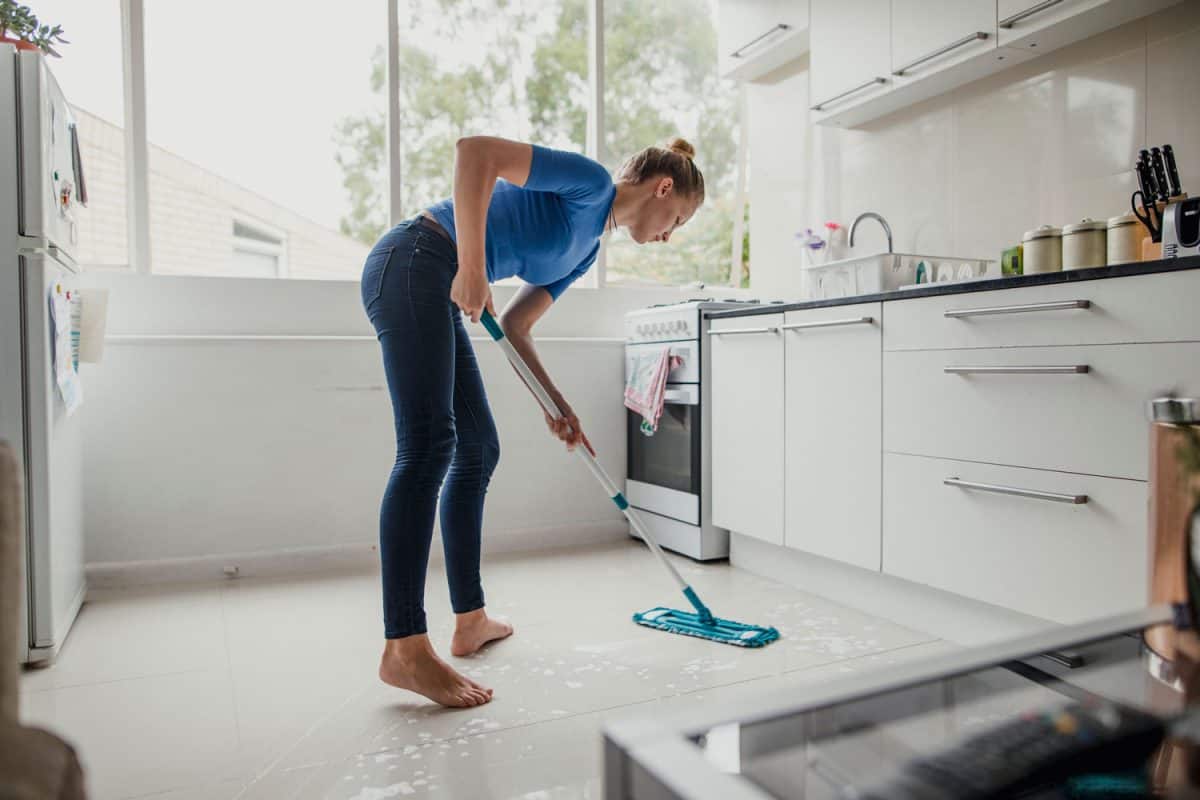
Many people have strong opinions over whether Swiffer pads are just as good as an old-fashioned mop. Some argue Swiffer offers people a more convenient and hygienic way to clean. On the other hand, mop fans argue that Swiffers are far more costly and don’t have the same deep-cleaning capabilities.
There’s no question the Swiffer is fantastic for giving your floor a quick sweep and for getting into hard-to-reach corners. However, there is a higher price—both financially and ecologically—for this convenience. Plus, some people have raised concerns over airborne particles from chemicals used to manufacture Swiffer products.
The truth is that both these cleaning products have pros and cons, which means you could use them for different purposes. For instance, you could use Swiffer pads for quick messes or general maintenance, but you should rely on a trusty mop for deep cleans.
Find out more on this Amazon link.
Mop Weekly For A Squeaky-Clean Kitchen!
No matter how clean you think you are while cooking, the kitchen floor always needs extra TLC. At a minimum, you should give your kitchen floor a thorough mop once per week. You should also sweep, Swiffer, or vacuum these floors once per day for the best results. If you follow this cleaning schedule, your floors should remain sparkly throughout the year.







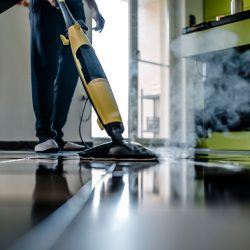
![Low angle view of a man mopping the floor in his kitchen, How To Make Kitchen Floor Less Slippery [With 5 Simple Methods]](https://kitchenseer.com/wp-content/uploads/2021/08/Low-angle-view-of-a-man-mopping-the-floor-in-his-kitchen-250x250.jpg)
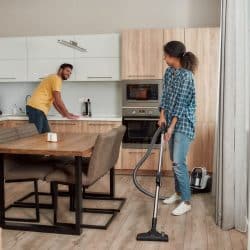
![Professional removing the cork flooring panels, How To Remove Cork Flooring From Concrete [Quickly & Easily]](https://kitchenseer.com/wp-content/uploads/2022/12/Professional-removing-the-cork-flooring-panels-250x250.jpg)

